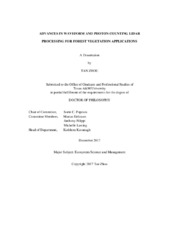| dc.contributor.advisor | Popescu, Sorin C. | |
| dc.creator | Zhou, Tan | |
| dc.date.accessioned | 2019-01-16T20:35:13Z | |
| dc.date.available | 2019-12-01T06:31:44Z | |
| dc.date.created | 2017-12 | |
| dc.date.issued | 2017-12-11 | |
| dc.date.submitted | December 2017 | |
| dc.identifier.uri | https://hdl.handle.net/1969.1/173146 | |
| dc.description.abstract | Full waveform (FW) and photon counting LiDAR (PCL) data have garnered greater attention due to increasing data availability, a wealth of information they contain and promising prospects for large scale vegetation mapping. However, many factors such as complex processing steps and scarce non-proprietary tools preclude extensive and practical uses of these data for vegetation characterization. Therefore, the overall goal of this study is to develop algorithms to process FW and PCL data and to explore their potential in real-world applications.
Study I explored classical waveform decomposition methods such as the Gaussian decomposition, Richardson–Lucy (RL) deconvolution and a newly introduced optimized Gold deconvolution to process FW LiDAR data. Results demonstrated the advantages of the deconvolution and decomposition method, and the three approaches generated satisfactory results, while the best performances varied when different criteria were used.
Built upon Study I, Study II applied the Bayesian non-linear modeling concepts for waveform decomposition and quantified the propagation of error and uncertainty along the processing steps. The performance evaluation and uncertainty analysis at the parameter, derived point cloud and surface model levels showed that the Bayesian decomposition could enhance the credibility of decomposition results in a probabilistic sense to capture the true error of estimates and trace the uncertainty propagation along the processing steps.
In study III, we exploited FW LiDAR data to classify tree species through integrating machine learning methods (the Random forests (RF) and Conditional inference forests (CF)) and Bayesian inference method. Results of classification accuracy highlighted that the Bayesian method was a superior alternative to machine learning methods, and rendered users with more confidence for interpreting and applying classification results to real-world tasks such as forest inventory.
Study IV focused on developing a framework to derive terrain elevation and vegetation canopy height from test-bed sensor data and to pre-validate the capacity of the upcoming Ice, Cloud and Land Elevation Satellite-2 (ICESat-2) mission. The methodology developed in this study illustrates plausible ways of processing the data that are structurally similar to expected ICESat-2 data and holds the potential to be a benchmark for further method adjustment once genuine ICESat-2 are available. | en |
| dc.format.mimetype | application/pdf | |
| dc.language.iso | en | |
| dc.subject | waveform LiDAR | en |
| dc.subject | photo counting LiDAR | en |
| dc.subject | ICESat-2 | en |
| dc.subject | decomposition | en |
| dc.subject | deconvolution | en |
| dc.subject | Gold | en |
| dc.subject | Richardson–Lucy (RL) | en |
| dc.subject | model reasonableness | en |
| dc.subject | tree species | en |
| dc.subject | Bayesian | en |
| dc.subject | uncertainty analysis | en |
| dc.subject | machine learning | en |
| dc.subject | Random forests | en |
| dc.subject | Conditional inference forests | en |
| dc.subject | noise filtering | en |
| dc.subject | photon classification | en |
| dc.subject | canopy height | en |
| dc.subject | ground elevation. | en |
| dc.title | Advances in Waveform and Photon Counting Lidar Processing for Forest Vegetation Applications | en |
| dc.type | Thesis | en |
| thesis.degree.department | Ecosystem Science and Management | en |
| thesis.degree.discipline | Ecosystem Science and Management | en |
| thesis.degree.grantor | Texas A & M University | en |
| thesis.degree.name | Doctor of Philosophy | en |
| thesis.degree.level | Doctoral | en |
| dc.contributor.committeeMember | Eriksson, Marian | |
| dc.contributor.committeeMember | Filippi, Anthony | |
| dc.contributor.committeeMember | Lawing, Michelle | |
| dc.type.material | text | en |
| dc.date.updated | 2019-01-16T20:35:14Z | |
| local.embargo.terms | 2019-12-01 | |
| local.etdauthor.orcid | 0000-0002-9193-5113 | |


